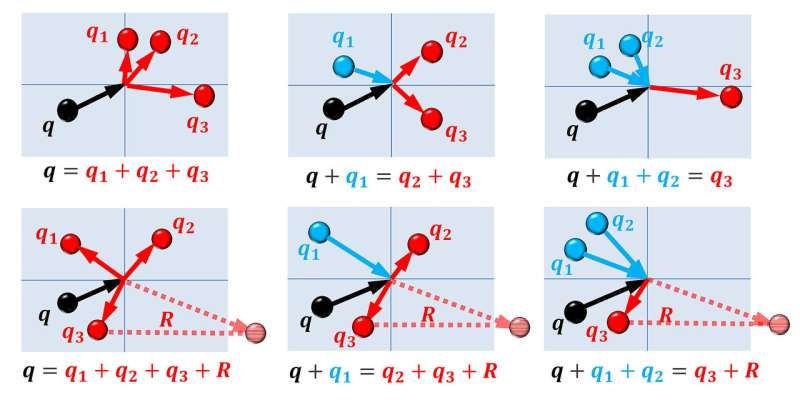Researchers solve 'four-phonon' thermal-conductivity obstacle key to tech applications

New findings have solved a longstanding obstacle in research to understand the effects of heat conduction in solid materials, a critical issue in many applications, from energy conversion to electronics cooling.
The discovery could aid efforts to improve a host of technologies including thermoelectric devices, which turn heat into electricity; thermal-barrier coatings such as those used to protect turbine-engine blades from extreme heating; heat sinks for electronics cooling; nuclear fuels; and research into solid-state heat transfer in general.
The research concerns the crucial role of "phonons," quantum-mechanical phenomena that describe how vibrations travel through a material's crystal structure. The phonons interact, sometimes combining and splitting into new phonons, changing direction and behavior.
This "scattering" is fundamental to how a material conducts heat. Until now, researchers have been able to realistically model only the interactions of three phonons. In new findings, however, researchers from Purdue University and Oak Ridge National Laboratory have shown how to accurately model the interactions of four phonons and their effect on heat flow.
"Being able to predict four-phonon scattering has been a decades-long challenge," said Xiulin Ruan, a Purdue professor of mechanical engineering.
Four-phonon interactions have long been ignored, in part because they were considered to be negligible and researchers didn't know how to model them.
"Now we have clearly shown the importance of four-phonon scattering," he said.
Findings were detailed in a paper appearing online in October in the journal Physical Review B. It was highlighted as a "Rapid Communications" paper, as the findings are especially timely and relevant. The paper was co-authored by former Purdue doctoral student Tianli Feng, who is now a postdoctoral researcher at the Vanderbilt University and Oak Ridge National Laboratory; Oak Ridge researcher Lucas Lindsay; and Ruan.
Until now, simulating four-phonon scattering has required 10,000 times the computational resources as three-phonon scattering, making it unfeasible to perform quality theoretical predictions. However, the Purdue team has developed a new method for carrying out the theoretical computations and optimized the simulation of four-phonon scattering, reducing the computational resources needed.
"It's a new physical picture," Feng said. "The mechanism of four-phonon scattering was already known, but nobody knew how to make the theoretical predictions or how to assess its importance, which are what we have achieved."
Being able to incorporate four-phonon data into calculations will help researchers develop new materials. Materials that have ultrahigh thermal conductivity are ideal for heat sinks, while those with low thermal conductivity are suited for thermoelectric applications and thermal barrier coatings.
The new findings demonstrate that only using three-phonon scattering in calculations produces results that overestimate the performance of some materials while underestimating the performance of others.
"The rigorous framework developed by the research team for including four-phonon scattering is novel and of significant scientific importance," said Alan McGaughey, a professor of mechanical engineering at Carnegie Mellon University. "Their findings shed important light on previous theoretical predictions and experimental measurements, and will help to guide the development of new materials for a broad range of applications. Of particular note is the potential to set limits on how high or low thermal conductivity can be across a range of temperatures."
Researchers are developing alternatives to diamond for applications such as heat sinks for electronics cooling. One such potential alternative, called zinc-blende boron arsenides, has been shown in theoretical calculations to rival diamond in thermal conductivity.
However, new findings applying four-phonon scattering show previous predictions overestimated the material's potential by over 50 percent at room temperature and even more at higher temperatures. Meanwhile, previous theoretical predictions were shown to underestimate the potential of silicon-based materials for thermoelectric applications at high temperatures.
"What we demonstrate here is that the theoretical upper limit is not as high as previously thought for zinc-blende boron arsenide," Lindsay said. "However, its predicted conductivity is still much higher than most materials, and it is still a promising system."
The research, which has been entirely theoretical, can explain the previous discrepancy between predicted and experimental thermal conductivities of silicon at high temperature. It will expand to include more laboratory experiments.
More information: Four-phonon scattering reduces thermal conductivity in graphene and the contributions from flexural phonons, journals.aps.org/prb/accepted/ … b82364802601217c0459
Journal information: Physical Review B
Provided by Purdue University





















